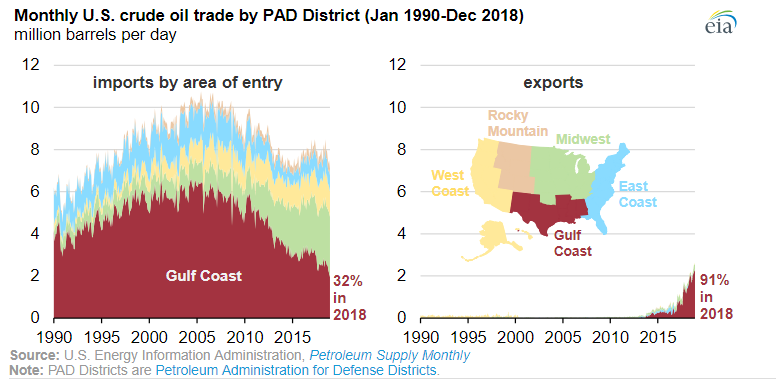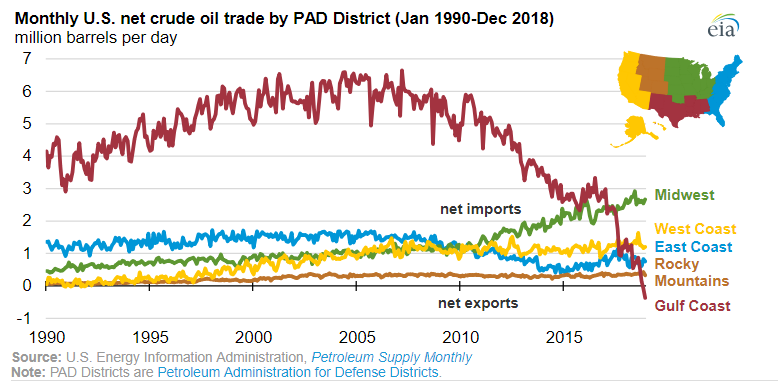In the last two months of 2018, the US Gulf Coast exported more crude oil than it imported, with monthly net trade of crude oil in the US Gulf Coast region (the difference between gross exports and gross imports) falling from a high in early 2007 of 6.6 million barrels per day of net imports to 0.4 million b/d of net exports in December 2018, according to EIA.
As gross exports of crude oil from the Gulf Coast hit a record 2.3 million b/d, gross imports of crude oil to the Gulf Coast in December—at slightly less than 2.0 million b/d—were the lowest level since March 1986.
Several continuing trends pushed crude oil exports higher and imports lower and resulted in the Gulf Coast (defined as Petroleum Administration for Defense District, or PADD, 3) becoming a net crude oil exporter in the last two months of 2018.
US crude oil production, particularly in the US Gulf Coast region, has increased in recent years. In November 2018, US Gulf Coast crude oil production set a new record of 7.7 million b/d. The increased production is mostly of light, sweet crude oils, but US Gulf Coast refineries are configured mostly to process heavy, sour crude oils.
This increasing production and mismatch between crude oil type and refinery configuration allows for more of the increasing US crude oil production to be exported.
As a result, in late 2018, US gross crude oil exports reached new record highs. Because more than 90% of US crude oil exports leave from the US Gulf Coast, crude oil exports from the region also set a record high of 2.3 million b/d in December. In each of the last three months of 2018, the US Gulf Coast exported more than 2 million b/d.
As US crude oil production has increased, US total and Gulf Coast region crude oil imports have decreased. In the mid-2000s, when both US total and Gulf Coast region crude oil imports were at their highest, the Gulf Coast accounted for nearly two-thirds of the national total.

More recently, as Gulf Coast crude oil imports have declined and other regions such as the Midwest and West Coast (PADDs 2 and 5, respectively) have increased their crude oil imports, the Gulf Coast’s share of total imports has decreased, most recently averaging 32% in 2018.
In addition, Gulf Coast gross crude oil imports reached record lows in the final months of 2018, with imports of 1.9 million b/d in December compared with 3.7 million b/d at the same time five years ago.
In particular, Gulf Coast crude oil imports from members of OPEC fell sharply in the final two months of 2018, from an average of 1.5 million b/d in the first half of 2018 to 1.1 million b/d in December.
The Gulf Coast is the first region to export more crude oil than it imports since the West Coast saw relatively small net exports in the early 1990s. The Midwest now has the highest net imports of crude oil of any PAD District, averaging 2.6 million b/d in 2018.
EIA’s latest Short-Term Energy Outlook forecasts that in 2020 the United States will begin exporting more petroleum and other liquids than it imports on an annual basis—an observation including not only crude oil but also petroleum products and hydrocarbon gas liquids.






























































